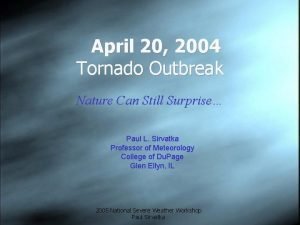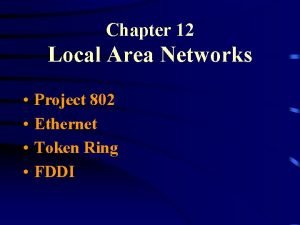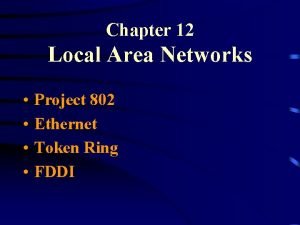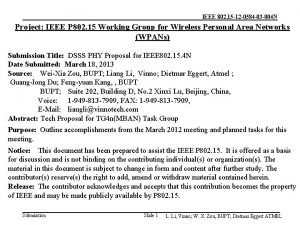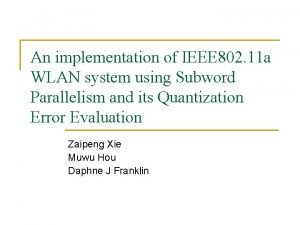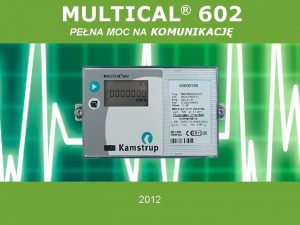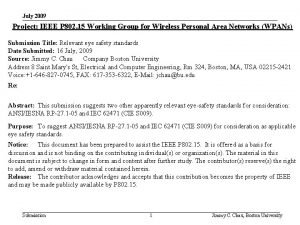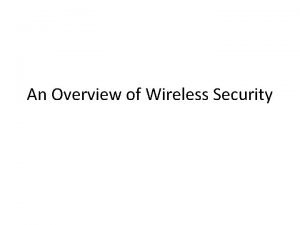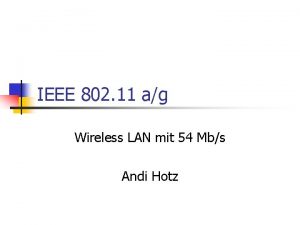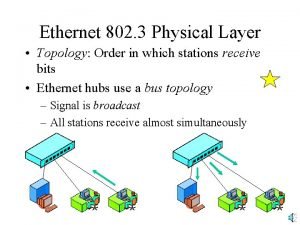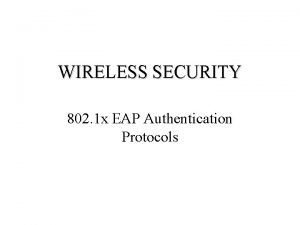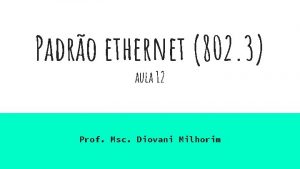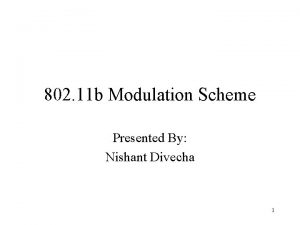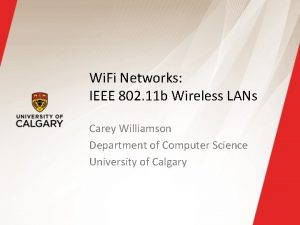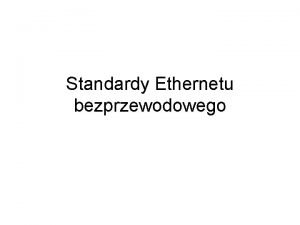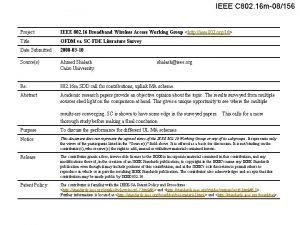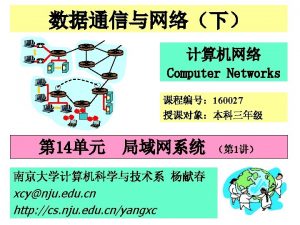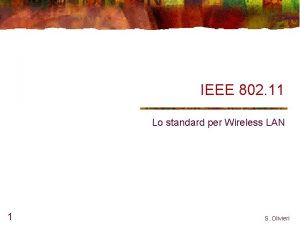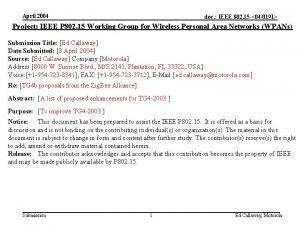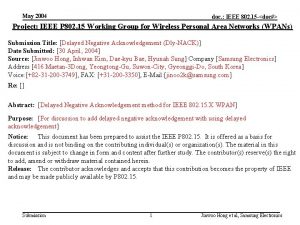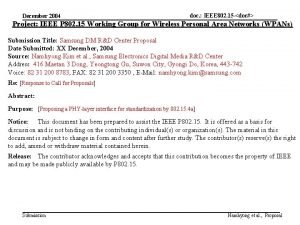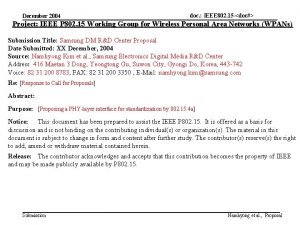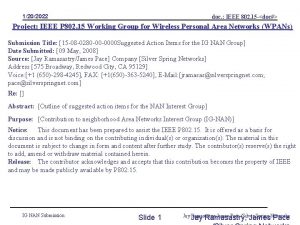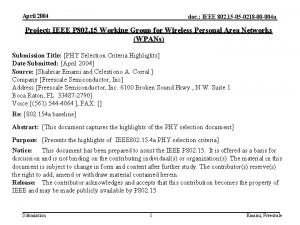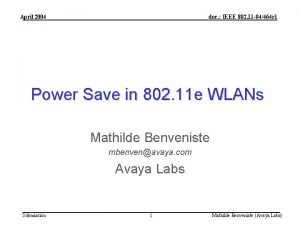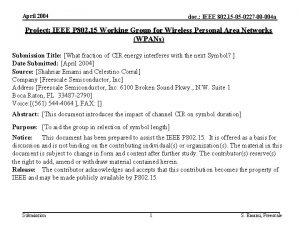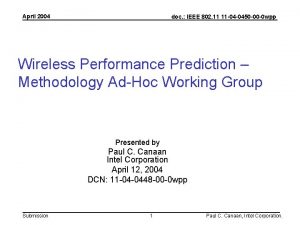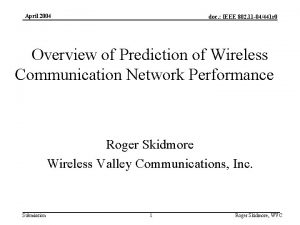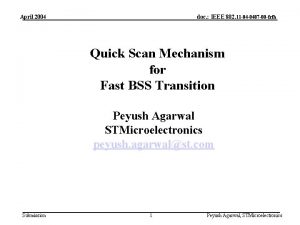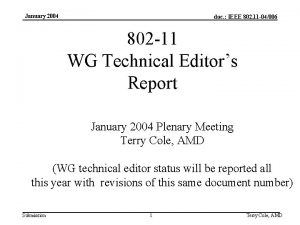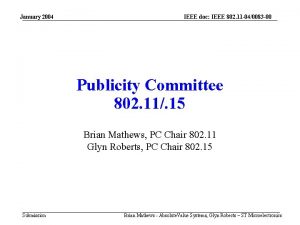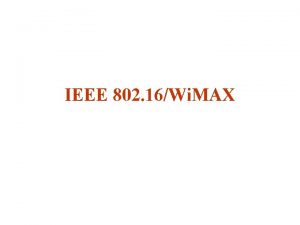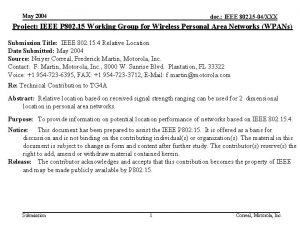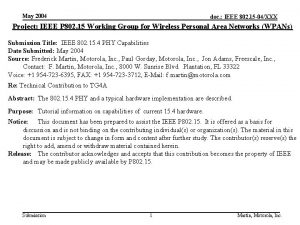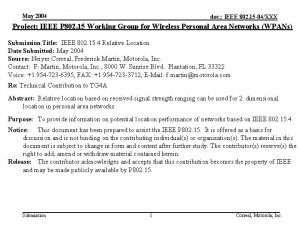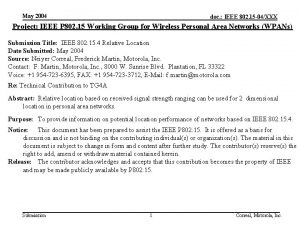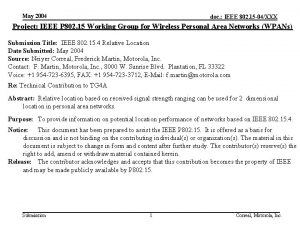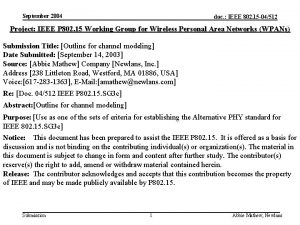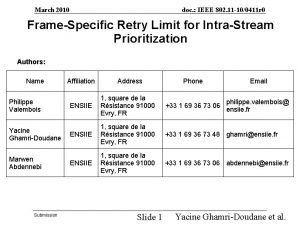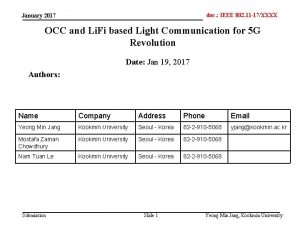April 2004 doc IEEE 802 15 040191 Project






































- Slides: 38

April 2004 doc. : IEEE 802. 15 -<04/0191> Project: IEEE P 802. 15 Working Group for Wireless Personal Area Networks (WPANs) Submission Title: [Ed Callaway] Date Submitted: [8 April 2004] Source: [Ed Callaway] Company [Motorola] Address [8000 W. Sunrise Blvd. , M/S 2141, Plantation, FL 33322, USA] Voice: [+1 -954 -723 -8341], FAX: [+1 -954 -723 -3712], E-Mail: [ed. callaway@motorola. com] Re: [TG 4 b proposals from the Zig. Bee Alliance] Abstract: [A list of proposed enhancements for TG 4 -2003. ] Purpose: [To improve TG 4 -2003. ] Notice: This document has been prepared to assist the IEEE P 802. 15. It is offered as a basis for discussion and is not binding on the contributing individual(s) or organization(s). The material in this document is subject to change in form and content after further study. The contributor(s) reserve(s) the right to add, amend or withdraw material contained herein. Release: The contributor acknowledges and accepts that this contribution becomes the property of IEEE and may be made publicly available by P 802. 15. Submission 1 Ed Callaway, Motorola

April 2004 doc. : IEEE 802. 15 -<04/0191> Zig. Bee Comments to TG 4 -2003 Submission 2 Ed Callaway, Motorola

April 2004 doc. : IEEE 802. 15 -<04/0191> PHY-1: MAC Timing Implied from the PHY Constraints Commenter Ian Marsden/Bhupender Virk, Comp. Xs Inc. Classification Clarification References 6. 7. 4 Transmit Centre Frequency Tolerance Summary The IEEE specification does not detail any MAC layer timing accuracy requirement, leaving them to be implied from the PHY constraints. Clarification is required in order to maintain the integrity of the slot boundaries within the superframe. Description The PAN timing is derived from the coordinator and the superframe structure it defines. All devices operating on the PAN will use timing derived from the PAN coordinator. The coordinator should maintain a timing accuracy of better than +/- 40 ppm. Under normal operating conditions the acceptable coordinator rate of clock drift must be within +-2 symbols after a maximum length superframe (Beacon. Order = 0 x 0 E). Normal conditions are defined where the operating temperature is constant. All devices should adhere to the Slot Boundary timing with an error of less than +/- 1 symbol throughout the entire superframe. An RFD may operate with relaxed specifications for slot boundary drift and jitter, but must take into account any potential error and ensure that it does not cause out of CAP transmissions. Submission 3 Ed Callaway, Motorola

April 2004 doc. : IEEE 802. 15 -<04/0191> PHY-2: PIB Attributes Commenter Ian Marsden/Bhupender Virk, Comp. Xs Inc. Classification Clarification References Section: 6. 2. 2. 6 PLME-GET. confirm Summary It is unclear how many bytes make up the PIBAttribute. Value field in the case of an UNSUPPORTED_ATTRIBUTE. It is proposed that in this case the field has zero length. Description See summary. Submission 4 Ed Callaway, Motorola

April 2004 doc. : IEEE 802. 15 -<04/0191> PHY-3: PLME-SET-TRX-STATE. request usage Commenter Ian Marsden/Bhupender Virk, Comp. Xs Inc. Classification Recommended practice References Section: 6. 2. 2. 8 PLME-SET-TRX-STATE. confirm Summary It is unclear what should be returned if a PLME-SET-TRX-STATE. request is issued selecting an unsupported state. It is recommended that a status of INVALID_PARAMETER is returned. Description See summary. Submission 5 Ed Callaway, Motorola

April 2004 doc. : IEEE 802. 15 -<04/0191> PHY-4: PD-DATA. request Usage Commenter Ian Marsden/Bhupender Virk, Comp. Xs Inc. Classification Recommended practice References Section: 6. 2. 1. 2 PD. DATA. confirm Summary It is unclear what should be returned if a PD-DATA. request is issued with a length greater than a. Max. PHYPacket. Size. It is recommended that a status of INVALID_PARAMETER is returned. Description See summary. Submission 6 Ed Callaway, Motorola

April 2004 doc. : IEEE 802. 15 -<04/0191> PHY-5: PIB Attributes Commenter Ian Marsden/Bhupender Virk, Comp. Xs Inc. Classification Recommended practice References Section: 6. 2. 2. 10 PLME-SET. confirm Summary It is unclear what should be returned if a PLME-SET. request is issued to change a PIB parameter that cannot be changed e. g. phy. Channels. Supported. It is recommended that a status of UNSUPPORTED_ATTRIBUTE is returned since the setting of this attribute is not supported. Description See summary. Submission 7 Ed Callaway, Motorola

April 2004 doc. : IEEE 802. 15 -<04/0191> MAC-1: Access to the Extended Address Commenter Ian Marsden/Bhupender Virk, Comp. Xs Inc. Classification Recommended practice References Table 70 and Table 71 Summary MAC sublayer constant a. Extended. Address can be accessed through the PAN information base, by way of parameter 0 x 6 F. Description This recommended practice describes the mapping of the MAC sublayer constant a. Extended. Address into MAC PAN information base parameter 0 x 6 F (mac. Extended. Address). As with other 802 specifications the configuration of the Extended Address upon power on is not precluded. This recommended practice describes how this is to be achieved. Upon power on, before attempting any radio activity, the next higher layer of a device which requires configuration of the a. Extended. Address will call MLME-SET. request(0 x 6 F, 0 x 1122334455667788). Where 0 x 1122334455667788 is the IEEE address to be set. Also through the provision of this extra parameter mac. Extended. Address the next higher layer can at any time read its Extended Address by way of a MLME-GET. request(0 x 6 F). Submission 8 Ed Callaway, Motorola

April 2004 doc. : IEEE 802. 15 -<04/0191> MAC-2: Starting a PAN Commenter Ian Marsden/Bhupender Virk, Comp. Xs Inc. Classification Clarification References Figure 76 PAN Start Summary When starting a PAN coordinator the ordering of MLMESTART. confirm and PLME-SET. TRX-STATE. request messages is not important. Description Figure 76 shows the transmission of the MLME-START. confirm before the PLME-SET-TRX-STATE. request. The order of these messages is implementation specific and either is acceptable in a compliant solution. Submission 9 Ed Callaway, Motorola

April 2004 doc. : IEEE 802. 15 -<04/0191> MAC-3: Starting a PAN Commenter Ian Marsden/Bhupender Virk, Comp. Xs Inc. Classification Recommended practice References Figure 76 PAN Start Summary On receipt of a MLME-RESET. request it is recommended that the MAC should issue a PLME-SET-TRX-STATE. request to ensure that the transceiver is off. Description Figure 76 shows a MLME-RESET. request however there is no PLMESETTRX-STATE. request to the PHY. Since the purpose of a reset it to return the entire stack to a known state it is recommended that the MAC issues a PLMESET-TRX-STATE. request to return the PHY to a known state. Submission 10 Ed Callaway, Motorola

April 2004 doc. : IEEE 802. 15 -<04/0191> MAC-4: Changing Channel Commenter Ian Marsden/Bhupender Virk, Comp. Xs Inc. Classification Recommended practice References Figure 80 Passive Scan Summary The MAC should always ensure that the transceiver is idle before changing the phy. Current. Channel parameter since the PHY has no way of indicating busy. Description Figure 80 shows the issuing of a PLME-SET. request(phy. Current. Channel), without first issuing a PLME-SET-TRX-STATE. request to force the PHY to idle. This is essential since the PLME-SET. confirm has no way of indicating the PHY is part way through receiving a message. The recommended practice is to always ensure the PHY is idle before attempting to issue a PLME-SET. request(phy. Current. Channel, New. Channel). If necessary the MAC should issue a PLME-SETTRXSTATE. request(FORCE_TRX_OFF). Submission 11 Ed Callaway, Motorola

April 2004 doc. : IEEE 802. 15 -<04/0191> MAC-5: Bit Ordering in Security Commenter Ian Marsden/Bhupender Virk, Comp. Xs Inc. Classification Typographical References Section: 7. 6. 1. 1 Bit Ordering Summary The phrase "The 16 th bit in an octet string is indexed as bit 0 of octet 2 and represents the low-order bit of the second octet”, should read “The 16 th bit in an octet string is indexed as bit 0 of octet 1 and represents the low-order bit of the second octet”. Description See summary. Submission 12 Ed Callaway, Motorola

April 2004 doc. : IEEE 802. 15 -<04/0191> MAC-6: CTR Encryption Commenter Ian Marsden/Bhupender Virk, Comp. Xs Inc. Classification Clarification References Section: 7. 6. 1. 4 CTR Encryption Summary The use of the term ‘Integrity Code’ is confusing since it is not used in AES-CTR and should be clarified. Description Add the sentence “Integrity code is not included if the security suite selected is AES-CTR. ” Before the sentence beginning “A nonce is a time stamp…”. Submission 13 Ed Callaway, Motorola

April 2004 doc. : IEEE 802. 15 -<04/0191> MAC-7: CBC-MAC Authentication Commenter Ian Marsden/Bhupender Virk, Comp. Xs Inc. Classification Clarification References Section: 7. 6. 1. 5 CBC-MAC Authentication Summary Clarification on what the ‘length’ described applies to. Description The phrase ". . . computed on a message that includes the length of the authenticated data at the beginning of the data themselves. " is not clear whether the 'length' applies to the authentication (a) or message (m) component of the integrity code. The number of bytes of length value is not defined. To be clarified the above phrase could be written as: ". . . computed on a message that includes the authentication data at the beginning of the data itself. ". Submission 14 Ed Callaway, Motorola

April 2004 doc. : IEEE 802. 15 -<04/0191> MAC-8: CBC-MAC Authentication Commenter Ian Marsden/Bhupender Virk, Comp. Xs Inc. Classification Typographical References Section: 7. 6. 1. 5 CBC-MAC Authentication Summary To avoid confusion and maintain consistency change ‘authenticated data’ to ‘authentication data’. Description The term ‘Authenticated’ applies to data which has been encrypted. So the Integrity code is actually generated from Authentication data not Authenticated data. Submission 15 Ed Callaway, Motorola

April 2004 doc. : IEEE 802. 15 -<04/0191> MAC-9: CCM Nonce Commenter Ian Marsden/Bhupender Virk, Comp. Xs Inc. Classification Clarification References Section: 7. 6. 3. 1. 3 CCM Nonce Summary Further clarification would be beneficial on the CCM Nonce. Description When generating the integrity code, the cipher block is used in CBC mode. This requires a 16 -byte cipher key, and a block of 16 bytes, block B 0, as the first block. More 16 -byte blocks containing padded authentication and padded message bytes follow on. Block B 0 is made up of the nonce as defined in this clause, plus 3 other bytes. The description of the nonce is woefully inadequate and the following sentences are proposed for clarity: "The first input block, B 0, applied to the CBC encryption function consists of a flags octet, the nonce shown below, and two octets indicating the number of bytes in the message field, l(m). Block B 0 forms a padded nonce. ". Submission 16 Ed Callaway, Motorola

April 2004 doc. : IEEE 802. 15 -<04/0191> MAC-10: CCM Commenter Ian Marsden/Bhupender Virk, Comp. Xs Inc. Classification Clarification References Section: 7. 6. 1. 6 CCM Summary Further clarification would be beneficial on the fact that a padded nonce is used in CCM. Description Block B 0 applied to a block cipher in CBC mode is made up of 16 bytes. The basic nonce of 13 bytes is padded with a flags byte and two l(m) bytes. To clarify this it is suggested that the phrase ". . . computed on a nonce followed by. . " should read ". . . computed on a padded nonce followed by. . ". Submission 17 Ed Callaway, Motorola

April 2004 doc. : IEEE 802. 15 -<04/0191> MAC-11: Secure Outgoing Frame Operations Commenter Ian Marsden/Bhupender Virk, Comp. Xs Inc. Classification Clarification References Section: 7. 6. 3. 3. 1 Outgoing Frame Operations Summary Further clarification would be beneficial on the fact that a padded nonce is used in CCM. Description The first block, B 0, applied to the generation of the integrity code is made up using a nonce with 3 additional bytes, (a padded nonce). This fact should be clarified by using the term padded nonce, to this end it would be clearer if ". . nonce. . " was prefixed with ". . padded. . ". Submission 18 Ed Callaway, Motorola

April 2004 doc. : IEEE 802. 15 -<04/0191> MAC-12: Secure Outgoing Frame Operations Commenter Ian Marsden/Bhupender Virk, Comp. Xs Inc. Classification Clarification References Section: 7. 6. 3. 3. 1 Outgoing Frame Operations Summary Further clarification would be beneficial on what makes up the authentication data fields. Description A brief description of the contents of the authentication data field is provided, with no further details concerning byte locations. It would be useful to add a clause similar to 7. 6. 3. 1. 3, entitled “Authentication data”. The clause should contain the following: In the AES-CCM security suite, the authentication data used for generating integrity code consists of bytes from the MAC frame. Figure xx specifies the order and length of the subfields of the authorization data. Figure xx should indicate the following: Octets 2 Frame control 1 Sequence number 2 Destination PAN ID 8 Destination address 2 Source PAN ID 8 Source address 4 Frame counter 1 Key Sequence counter FCS has not been included as it serves to provide a first level check on the quality of the received data. The only nonpayload field in the MAC payload apart from the MAC header is the FCS field. It is assumed that the FCS enables a without-encryption validation check on the whole of the MAC frame and is the last field to be generated prior to transmission. As such, it should not be included in the authentication process. A further clarification should be made by changing the sentence "Use the MAC header and non-payload fields in the MAC payload as the authentication data, a. . . " to read "Use the MAC header field in the MAC payload as the authentication data, a. . . ". Submission 19 Ed Callaway, Motorola

April 2004 doc. : IEEE 802. 15 -<04/0191> MAC-13: Secure Processing of Outgoing Frames Commenter Ian Marsden/Bhupender Virk, Comp. Xs Inc. Classification Clarification References Section: 7. 5. 8. 4. 1 Processing outgoing Frames Summary The term ‘Integrity code’ is used here as a process, not as data. It would be beneficial to clarify that what is being described here is the process. Description Change the phrase ". . , the integrity code shall be applied to the MHR. . . “to read ". . , the integrity code process shall be applied to the MHR. . . ". Submission 20 Ed Callaway, Motorola

April 2004 doc. : IEEE 802. 15 -<04/0191> MAC-14: PIB Security Material Commenter Ian Marsden/Bhupender Virk, Comp. Xs Inc. Classification Clarification References Section: 7. 6. 1. 8 PIB Security Material Summary The description here implies that the Key Sequence Counter is a fixed value. Description The key sequence counter in the MAC is set up with a value which is provided by a higher layer, it is not a fixed value. To prevent confusion, the phrase ". . The key sequence counter is a counter that is fixed by the. . . " should be changed to ". . The key sequence counter is a counter whose value is determined by the. . . ”. Submission 21 Ed Callaway, Motorola

April 2004 doc. : IEEE 802. 15 -<04/0191> MAC-15: PIB Security Material Commenter Ian Marsden/Bhupender Virk, Comp. Xs Inc. Classification Clarification References Section: 7. 6. 1. 8 PIB Security Material Summary The description here is not clear which messages get a copy of the Key Sequence Counter. Description The type of payload field in which the key sequence counter is inserted is not clearly stated. The phrase ". . . MAC payload of the MAC frame. " should be clarified as ". . . MAC payload of the transmitted MAC frame. ". Submission 22 Ed Callaway, Motorola

April 2004 doc. : IEEE 802. 15 -<04/0191> MAC-16: AES-CTR Security Suite Commenter Ian Marsden/Bhupender Virk, Comp. Xs Inc. Classification Clarification References Section: 7. 6. 2 AES-CTR security Suite Summary The description here is not clear what is meant by ‘Shared data’ Description The term 'shared data' refers to the 8 bytes of Source Address. The phrase ". . . within the MAC payload using shared data, the. . . " clarified as ". . . within the MAC payload using the Source address, the. . . ". Submission 23 Ed Callaway, Motorola

April 2004 doc. : IEEE 802. 15 -<04/0191> MAC-17: Coordinator Realignment Commenter Ian Marsden/Bhupender Virk, Comp. Xs Inc. Classification Recommended practice References Section: 7. 1. 14. 1. 3 Effect on receipt Summary Unless a device on a network has mac. Rx. On. Idle set it is extremely unlikely to receive Coordinator Realignment commands indicating that the coordinator is changing the channel or PANID. Recommended practice is to substitute a beacon with the realignment message. Description During normal operation devices on a network will only enable their receiver at the beginning of each superframe in order to receive the beacon. Messages transmitted at other times will not be received. Transmitting the realignment command at an arbitrary point in the superframe will not be received by the majority of devices. The change in PAN parameters will cause most devices to lose synchronization and indicate a BEACON_LOST to the next higher layer. This is undesirable since the default action of a network layer (MLMLSYNC. request) will fail, and each device can only rejoin the network through an Orphan Scan. It is recommended that when the next higher layer of a coordinator attempts to update the superframe specification through use of the MLME-START. request with the Coord. Realignment bit set the command should be transmitted in place of the last beacon of the original configuration. This practice will maximize the probability of the devices on the PAN receiving the command successfully. It is also recommended that the coordinator maintains super frame timing throughout the procedure to minimize the chance of a SYNC-LOSS on the devices. Submission 24 Ed Callaway, Motorola

April 2004 doc. : IEEE 802. 15 -<04/0191> MAC-18: PAN Identifier Conflict Resolution Commenter Ian Marsden/Bhupender Virk, Comp. Xs Inc. Classification Clarification References Section: 7. 5. 2. 2. 2 Resolution Summary The description does not explicitly state that the next higher layer is responsible for the Active Scan and selection of the new network parameters. Description The text should be clarified as follows: “On the detection of a PAN identifier conflict, the next higher layer on the coordinator shall first perform an active scan and then, using the information from the scan, select a new PAN identifier. ” The next higher layer will issue an MLME-START. request with the realignment parameter set. This will inform the devices on the network of the updated network parameters. Submission 25 Ed Callaway, Motorola

April 2004 doc. : IEEE 802. 15 -<04/0191> MAC-19: Active Channel Scan Commenter Ian Marsden/Bhupender Virk, Comp. Xs Inc. Classification Discussion References Section: 7. 5. 2. 1. 2 Active Channel Scan Summary The fact that beacon enabled PANs ignore beacon request commands dictates that, unless long Active Scan durations are used, PANs with a large Beacon. Order are unlikely to be detected during the active scan. Description Were every coordinator to issue an Ad. Hoc beacon upon receipt of the Beacon Request command, as required from the coordinator of a beaconless network, scan times could be reduced and MLME-SCAN. confirm primitives would describe the channel activity more accurately. Option 1: Coordinators may issue an adhoc beacon on receipt of a beacon request command under CSMA. An Ad. Hoc beacon is defined as a beacon with a Super. Frame. Order of 0 x 0 F. All other beacon parameters including the Beacon. Order should be valid for the PAN. Option 1 b: As option 1, except that only coordinators of a PAN where the Beacon. Order is greater than 5 will issue the Ad. Hoc Beacon. Option 2: Coordinators may issue an adhoc beacon on receipt of a beacon request command under CSMA. And Ad. Hoc beacon is defined as a beacon with a new “Ad. Hoc beacon” flag set within the Superframe specification, which would be set in Ad. Hoc beacons issued by a coordinator on receipt of a beacon request command. Option 2 b: As option 2, except that only coordinators of a PAN where the Beacon. Order is greater than 5 will issue the Ad. Hoc Beacon. Submission 26 Ed Callaway, Motorola

April 2004 doc. : IEEE 802. 15 -<04/0191> MAC-20: Promiscuous Mode Commenter Ian Marsden/Bhupender Virk, Comp. Xs Inc. Classification Recommended practice References Section: 7. 5. 6. 2 Reception and rejection Summary The sentence “The MAC sublayer shall pass all frames received … directly to the upper layers” does not describe the format of the message sent up. Description The recommended practice is that the entire PSDU is sent to the next higher layer through a MCPS-DATA. indication primitive, where the received PSDU is included as the MSDU parameter. In order to identify that this MCPSDATA. indictaion primitive contains an un-filtered PSDU the Dst. Addr. Mode and Src. Addr. Mode fields are both set to 0 x 01 (No Address). The mpdu. Link. Quality field is valid. Submission 27 Ed Callaway, Motorola

April 2004 doc. : IEEE 802. 15 -<04/0191> MAC-21: PIB Attributes Commenter Ian Marsden/Bhupender Virk, Comp. Xs Inc. Classification Clarification References Section: 7. 1. 6. 2 MLME-GET. confirm Summary It is unclear how many bytes make up the PIBAttribute. Value field in the case of an UNSUPPORTED_ATTRIBUTE. It is proposed that in this case the field has zero length. Description See summary. Submission 28 Ed Callaway, Motorola

April 2004 doc. : IEEE 802. 15 -<04/0191> MAC-22: Data Request Command Frame Commenter Ian Marsden/Bhupender Virk, Comp. Xs Inc. Classification Clarification References Section: 7. 3. 2. 1. 1 MHR fields Summary The text within section 7. 3. 2. 1. 1 describing the data request command frame “the source addressing mode sub field shall be set to 3 if the value of mac. Short. Address is equal to either 0 x. FFFE or 0 x. FFFF or set to 2 otherwise. ” does not adequately describe all possible uses of this command. Description The data request command may be generated in two ways: 1. When a MLME-POLL. request is received by the MAC. 2. When mac. Auto. Request is set to true and the MAC detects a message pending. This first case is detailed in the specification 7. 3. 2. 1. 1 where the value of mac. Short. Address determines the source addressing mode. Clarification is required for the second case, where the MAC should use the source addressing mode corresponding to that of the pended message. Submission 29 Ed Callaway, Motorola

April 2004 doc. : IEEE 802. 15 -<04/0191> MAC-23: Disassociation Notification Command Frame Commenter Ian Marsden/Bhupender Virk, Comp. Xs Inc. Classification Typographical References Section: 7. 3. 1. 3 Disassociation Notification Command Summary The Disassociation Notification Command should be transmitted using the short address if one has been allocated to the destination device. Description The text contained with section 7. 3. 1 is incomplete and should read “the destination addressing mode and source addressing mode sub fields of the frame control field shall both be set to 3 if the value of mac. Short. Address within the device to be disassociated is equal to either 0 x. FFFE or 0 x. FFFF or set to 2 otherwise. ”. Submission 30 Ed Callaway, Motorola

April 2004 doc. : IEEE 802. 15 -<04/0191> MAC-24: Beacon Generation Commenter Ian Marsden/Bhupender Virk, Comp. Xs Inc. Classification Discussion References Section: 7. 5. 2. 4 Beacon Generation Summary There is a problem with 7. 5. 2. 4 wrt beacon generation: The section states “All beacon frames shall be transmitted at the beginning of each superframe at an interval equal to a. Base. Superframe. Duration*2 n symbols, where n is the value of mac. Beacon. Order. The beacon frame shall be constructed as specified in 7. 2. 2. 1. ”. This means that a PAN coordinator and Device both beaconing will always trample each others beacons. Description Possible solutions include: 1. Adhoc beacons 2. Devices transmit adhoc beacons using CSMA in the CAP. 3. Beacons are transmitted with a GTS 4. The device request a transmit GTS from the PAN coordinator and transmits a beacon which describes a superframe the Active period of which is contained entirely within the allocated GTS. 5. Beacons are transmitted following the beacon of the PAN coordinator 6. The device transmits beacon immediately following the beacon of the PAN coordinator without CSMA. 7. The device transmits it own superframe base on its local clock. Submission 31 Ed Callaway, Motorola

April 2004 doc. : IEEE 802. 15 -<04/0191> MAC-25: Intra-PAN Subfield Commenter Discussed during the Austin member meeting Classification Inconsistency References 7. 2. 1. 1. 5 Intra-PAN subfield and 7. 5. 6. 1 Transmission Summary Intra-PAN subfield Description In section “ 7. 2. 1. 1. 5 Intra-PAN subfield”: If this subfield is set to 1 and both destination and source addresses are present, the frame shall not contain the source PAN identifier field. And in section “ 7. 5. 6. 1 Transmission”: If both destination and source addressing information is present, the MAC sublayer shall compare the destination and source PAN identifiers. If the PAN identifiers are identical, the intra-PAN subfield of the frame control field shall be set to 1, and the source PAN identifier shall be omitted from the transmitted frame. There is a conflict between the above and the octets description in the figures throughout section 7. 3, if the intra-PAN subfield is set and the source PAN identifier is omitted. The suggested solution is to use what specified in section 7. 2. 1. 1. 5 and 7. 5. 6. 1, thus use the intra-PAN subfield and omit the source PAN identifier if destination and source PAN identifiers are the same. Submission 32 Ed Callaway, Motorola

April 2004 doc. : IEEE 802. 15 -<04/0191> MAC-26: Bits in Security Commenter Discussed during the Austin member meeting Classification Clarification References 7. 6 and Annex B Summary Security Description It has been mentioned that LSB and MSB are not the same in section 7. 6 and in Annex B. The bits in section 7. 6 are sent over the air in the opposite direction of the bits in the rest of the spec. This needs more investigation. Submission 33 Ed Callaway, Motorola

April 2004 doc. : IEEE 802. 15 -<04/0191> MAC-27: CCM* Commenter Discussed during the Austin member meeting Classification Zig. Bee decision References Summary Zig. Bee has chosen to use CCM* instead of CCM Description Whether the identifier corresponds to similar security suite needs to be clarified. Submission 34 Ed Callaway, Motorola

April 2004 doc. : IEEE 802. 15 -<04/0191> MAC-28: GTS Commenter Discussed during the Austin member meeting Classification Zig. Bee decision References Summary GTS is no longer mandatory for a FFD. Description See summary. Submission 35 Ed Callaway, Motorola

April 2004 doc. : IEEE 802. 15 -<04/0191> MAC-29: Beacon Tracking Commenter Discussed during the Austin member meeting Classification Zig. Bee decision References Summary The code for tracking beacons is no longer necessary in devices that only support non-beacon-enabled networks. Description See summary. Submission 36 Ed Callaway, Motorola

April 2004 doc. : IEEE 802. 15 -<04/0191> MAC-30: mac. Rx. On. When. Idle Commenter Discussed during the Austin member meeting Classification Clarification References Summary mac. Rx. On. When. Idle and nonbeacon-enabled PAN Description The MAC PIB attribute mac. Rx. On. When. Idle shall be set to TRUE on a nonbeacon-enabled network when the MLME-START. request primitive is called in order to initiate a PAN, if the coordinator wants to have its receiver turned on. This clarification is supported by section ” 7. 5. 1. 1 Superframe structure”: If BO = 15, … mac. Rx. On. When. Idle shall define whether the receiver is enabled during periods of transceiver inactivity. Submission 37 Ed Callaway, Motorola

April 2004 doc. : IEEE 802. 15 -<04/0191> MAC-31: Disassociation Commenter Discussed during the Austin member meeting Classification Problem References Summary Disassociation Description The problem with disassociate in the 802. 15. 4 is that communication between devices in the network is done by the short addresses of the devices, if these have been allocated, and the address parameter, in the disassociate primitive, is the 64 -bit IEEE address of the device to disassociate. On a coordinator the disassociate shall be send indirect with the destination address set to the 64 -bit IEEE address, but the device sends the data requests with its short address and therefore it will never receive the disassociate command. Suggested solution 1: In a beacon-enabled network, section 7. 3. 2. 1. 1 should be changed to allow that the source address in the data request could be the a. Extended. Address if this is indicated in the beacon frame. Furthermore, a mapping table shall be in the MAC and it shall compare the received address with both the short address and the corresponding 64 -bit IEEE address on the data, which is to be sent indirectly. Suggested solution 2: To make the communication over the air more homogeneous, the short address of the device to disassociate shall be added as a parameter to the MLME-DISASSOCIATE. request primitive. The destination address and source address shall be what is used in the network, either short or extended address, and the extended address shall be added to disassociation notification command format (figure 51). It has to be investigated which impact it would have if another device send a data request (with the right PAN ID and short address) and got the packet, but the 64 -bit IEEE address didn't match. The coordinator would think it had disassociated the device, but it had not. If a device receives a disassociate command with a wrong 64 -bit IEEE address the MAC sublayer shall discard the incoming frame. Section “ 7. 3. 1. 3 Disassociation notification command” shall be updated to reflect the suggested changes. Submission 38 Ed Callaway, Motorola
 Bridges from 802.x to 802.y
Bridges from 802.x to 802.y Bridges from 802.x to 802.y
Bridges from 802.x to 802.y Ieee 802 que es
Ieee 802 que es 802 ieee
802 ieee Ieee 802 family
Ieee 802 family Ieee 802
Ieee 802 Ieee 802 standard
Ieee 802 standard Ieee 802
Ieee 802 Ieee 802 3 compliance
Ieee 802 3 compliance Arquitetura ieee 802
Arquitetura ieee 802 Ieee 802 bluetooth
Ieee 802 bluetooth Apod nasa gov calendar 1982
Apod nasa gov calendar 1982 Tornado outbreak of april 20, 2004
Tornado outbreak of april 20, 2004 Project 802 in data communication network
Project 802 in data communication network Project 802
Project 802 April art project
April art project Mac address
Mac address 802 15
802 15 Wlan 802
Wlan 802 Geo 802
Geo 802 Kamstrup multical 802
Kamstrup multical 802 09 802 0561
09 802 0561 802-11-wireless-security
802-11-wireless-security 802 5
802 5 Wireless lan 802
Wireless lan 802 802 3
802 3 802 eap
802 eap Sybex ccna
Sybex ccna 802 3
802 3 802 16
802 16 802 11
802 11 Ssin-802
Ssin-802 802 11 b
802 11 b Standardy 802
Standardy 802 Lan 701
Lan 701 507-802-380
507-802-380 Nn dfe
Nn dfe 802 protocols
802 protocols 802/11
802/11












